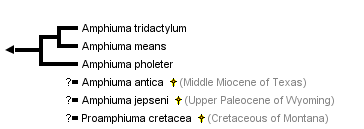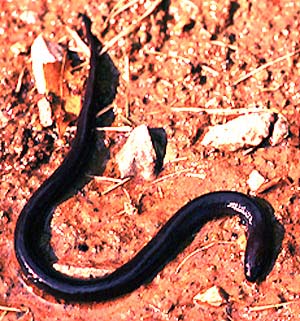Amphiumidae
Amphiumas
Allan Larson


This tree diagram shows the relationships between several groups of organisms.
The root of the current tree connects the organisms featured in this tree to their containing group and the rest of the Tree of Life. The basal branching point in the tree represents the ancestor of the other groups in the tree. This ancestor diversified over time into several descendent subgroups, which are represented as internal nodes and terminal taxa to the right.

You can click on the root to travel down the Tree of Life all the way to the root of all Life, and you can click on the names of descendent subgroups to travel up the Tree of Life all the way to individual species.
For more information on ToL tree formatting, please see Interpreting the Tree or Classification. To learn more about phylogenetic trees, please visit our Phylogenetic Biology pages.
close boxRelationships among the three extant species of the family Amphiumidae are based upon the allozymic study of Karlin and Means (1994). For more information about the extinct species, see Estes (1981).
Introduction
Salamanders of the family Amphiumidae are elongate (length may exceed 1 meter) and permanently aquatic, although adults lack gills and use lungs to breathe air. Both forelimbs and hindlimbs are extremely reduced in size and appear nonfunctional, although the animals move them. Three extant species of the genus Amphiuma differ in the number of toes present on the limbs, from one (A. pholeter), to two (A. means) or three (A. tridactylum). Larvae hatch with external gills and transform partially, losing the gills but retaining one pair of gill slits.
Amphiumas inhabit swamps, bayous, marshes, drainage ditches and streams in the southeastern United States. Amphiuma means is distributed in the Atlantic and Gulf coastal states from Virginia, south to Florida and west to Louisiana. Amphiuma tridactylum occurs in Louisiana and surrounding areas of Texas, Arkansas and Mississippi, and enters parts of Alabama, Missouri and Oklahoma. Amphiuma pholeter is restricted to a small area at the base of the Florida panhandle and an adjacent part of Georgia.
Amphiumas are nocturnally active, generalist predators that feed on crayfish, frogs, fish and small snakes. They serve as prey for larger snakes including cottonmouths and mudsnakes. Large amphiumas have a powerful bite that is unusual for salamanders and they should not be handled carelessly.
Breeding has been observed for the two-toed and three-toed amphiumas. These amphiumas breed in the winter or spring, fertilize eggs internally, and lay a string of eggs in muddy, shallow water. Eggs are guarded until they hatch in the summer or fall.
Characteristics
Diagnosis
Large, aquatic salamanders that retain some larval characteristics as adults (one of three pairs of larval gill slits, eyes small and without eyelids) but which lose external gills at adulthood. The body is cylindrical and highly elongated. Limbs are present in two pairs but are extremely tiny relative to the large size of the body. Despite their aquatic lifestyle, amphiumas breathe air through lungs by periodically poking the nostrils above the surface of the water.
Detailed Characteristics of the Amphiumidae
The morphological characters given below are the ones standardly used to diagnose the salamander family Amphiumidae and to assess its phylogenetic relationships to other salamanders. The individual characteristics are in most cases shared with other salamanders and should not be interpreted as synapomorphies of the Amphiumidae. Absence of characteristics found in other salamanders is noted where it is important for distinguishing amphiumas from other salamanders and/or determining their relationships to other salamanders. These characteristics were assembled from a large number of original sources by Duellman and Trueb (1986), Larson (1991) and Larson and Dimmick (1993).
Metamorphosis is incomplete in the Amphiumidae, leading to a number of paedomorphic characteristics in adults.
Morphology of the Head
Premaxillae are fused to form a single bone. Bilaterally paired nasal bones each ossify from a single, laterally positioned anlage; long posterior processes of the premaxillae extend between the paired nasal bones and completely separate them. Maxillary bones are present and well developed. Septomaxillary bones are absent. Lacrimal bone is absent. Quadratojugal bone is absent. Pterygoid bones are present but small. The angular bone is fused to the mandible. An internal carotid foramen is present in the parasphenoid bone. Ear bones include a detached columella but no operculum. Replacement of vomerine teeth proceeds laterally in parallel to the maxillary teeth. Teeth have a distinct crown and pedicel. Origin of the levator mandibulae anterior superficialis muscle includes the exoccipital. Eyelids are absent.
Inner Ear
A basilaris complex is present in the inner ear. The recessus amphibiorum is oriented horizontally in the inner ear. The otic sac is multilobate, vascularized and filled with calcium. The amphibian periotic canal lacks fibrous connective tissue. The periotic cistern is large. The periotic cistern does not protrude into the fenestra.
Hyobranchial Structures
The first hypobranchial and first ceratobranchial (alternatively homologized as the first ceratobranchial and first epibranchial, respectively) are fused together. The second ceratobranchial (alternatively homologized as the second epibranchial) comprises four elements. An ypsiloid cartilage is absent. Lungs are present. Larvae have three pairs of gill slits, and a single pair of gill slits persists in adults.
Characteristics of the Trunk and Vertebral Column
Forelimbs and hind limbs highly reduced, as are the pectoral and pelvic girdles. The scapula and coracoid bones of the pectoral girdle are fused to form the scapulocoracoid. Vertebral centra are amphicoelous. Ribs are bicapitate. A progression from partial to complete spinal-nerve foramina is observed in neural arches of caudal vertebrae 3-8; such foramina are absent from other vertebrae. The pubotibialis and puboischiotibialis exist as separate muscles. Anterior glomeruli of the kidney are reduced or absent.
Reproductive Characters
Fertilization is internal. Ciliated epithelium is present in the cloacal tube and/or anterior cloacal chamber of females. Epidermal lining is absent from the anterior cloacal chamber of females. Evaginations are absent from the dorsolateral walls of the male cloacal tube. Anterior ventral glands are absent from the cloacae of females. Spermathecae are present in the female cloacal chamber. Glands secreting into the dorsal walls of the female cloaca are absent. Anterior ventral glands are present in male cloacae. Posterior ventral glands are absent from male cloacae. Kingsbury's glands are absent from male cloacae. Dorsal pelvic glands are present in males. Lateral pelvic glands are absent in males. Glands secreting into the male cloacal orifice are present. Parental care of eggs is by females.
The diploid number of chromosomes is 28.
Classification
In addition to Amphiuma, the family Amphiumidae contains a single extinct species in the genus Proamphiuma. This Cretaceous genus is distinguished from Amphiuma by a less pronounced elaboration of the vertebral features associated with specialized, intervertebral muscles that are unique to amphiumids. Estes (1981) describes Proamphiuma as a "good structural ancestor" for Amphiuma.
Estes (1981) placed the Amphiumidae in a distinct suborder, Amphiumoidea, although later authors have included them in a large suborder, Salamandroidea, that includes all internally-fertilizing salamanders (Duellman and Trueb, 1986).
Discussion of Phylogenetic Relationships
The Amphiumidae is clearly a monophyletic group that is not closely related to any other salamanders. Several lines of evidence have suggested that the Amphiumidae may be the sister taxon to the lungless salamander family Plethodontidae (Salthe and Kaplan, 1966; Larson, 1991; Larson and Dimmick, 1993), although this grouping has not been demonstrated with statistical significance. Even if these families are sister taxa, however, their evolutionary divergence was nonetheless an ancient one.
An allozymic study of the products of 24 presumptive genetic loci (Karlin and Means, 1994) indicates a fairly close relationship between Amphiuma means and A. tridactylum (Nei's genetic distance = 0.12) and a much more distant relationship between either of these species and A. pholeter (Nei's genetic distance = 0.73-0.90). These data provide convincing evidence that A. means and A. tridactylum are sister taxa and that these species are collectively the sister taxon to A. pholeter.
References
Duellman, W. E. and L. Trueb. 1986. Biology of Amphibians. McGraw-Hill, New York.
Estes, R. 1981. Gymnophiona, Caudata. Handbuch der Paläoherpetologie 2:1-115.
Karlin, A. A. and D. B. Means. 1994. Genetic variation in the aquatic salamander genus Amphiuma. American Midland Naturalist 132:1-9.
Larson, A. 1991. A molecular perspective on the evolutionary relationships of the salamander families. Evolutionary Biology 25:211-277.
Larson, A. and W. W. Dimmick. 1993. Phylogenetic relationships of the salamander families: A analysis of congruence among morphological and molecular characters. Herpetological Monographs 7:77-93.
Salthe, S. N. and N. O. Kaplan. 1966. Immunology and rates of enzyme evolution in the Amphibia in relation to the origins of certain taxa. Evolution 20:603-616.
About This Page
David Heyse, Todd Jackman, and J. Robert Macey contributed to the preparation of this Tree of Life page.
Allan Larson

Washington University, St. Louis, Missouri, USA
Page copyright © 1996 Allan Larson
All Rights Reserved.
Citing this page:
Larson, Allan. 1996. Amphiumidae. Amphiumas. Version 01 January 1996 (under construction). http://tolweb.org/Amphiumidae/15440/1996.01.01 in The Tree of Life Web Project, http://tolweb.org/








 Go to quick links
Go to quick search
Go to navigation for this section of the ToL site
Go to detailed links for the ToL site
Go to quick links
Go to quick search
Go to navigation for this section of the ToL site
Go to detailed links for the ToL site